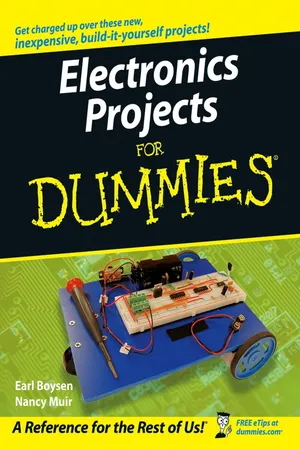
- English
- ePUB (mobile friendly)
- Available on iOS & Android
Electronics Projects For Dummies
About this book
These projects are fun to build and fun to use
Make lights dance to music, play with radio remote control, or build your own metal detector Who says the Science Fair has to end? If you love building gadgets, this book belongs on your radar. Here are complete directions for building ten cool creations that involve light, sound, or vibrations -- a weird microphone, remote control gizmos, talking toys, and more, with full parts and tools lists, safety guidelines, and wiring schematics. Check out ten cool electronics projects, including
* Chapter 8 -- Surfing the Radio Waves (how to make your own radio)
* Chapter 9 -- Scary Pumpkins (crazy Halloween decorations that have sound, light, and movement)
* Chapter 12 -- Hitting Paydirt with an Electronic Metal Detector (a project that can pay for itself) Discover how to
* Handle electronic components safely
* Read a circuit diagram
* Troubleshoot circuits with a multimeter
* Build light-activated gadgets
* Set up a motion detector
* Transform electromagnetic waves into sound Companion Web site
* Go to www.dummies.com/go/electronicsprojectsfd
* Explore new projects with other electronics hobbyists
* Find additional information and project opportunities
Frequently asked questions
- Essential is ideal for learners and professionals who enjoy exploring a wide range of subjects. Access the Essential Library with 800,000+ trusted titles and best-sellers across business, personal growth, and the humanities. Includes unlimited reading time and Standard Read Aloud voice.
- Complete: Perfect for advanced learners and researchers needing full, unrestricted access. Unlock 1.4M+ books across hundreds of subjects, including academic and specialized titles. The Complete Plan also includes advanced features like Premium Read Aloud and Research Assistant.
Please note we cannot support devices running on iOS 13 and Android 7 or earlier. Learn more about using the app.
Information
Part I
Project Prep

Chapter 1
Exploring the World of Electronics Projects
In This Chapter




What Is an Electronics Project, Anyway?
Electronics, mechanics, robotics: Huh?
Programmable versus nonprogrammable
Battery-powered versus 120 volts+
Table of contents
- Title
- Contents
- Introduction
- Part I : Project Prep
- Part II : Sounding Off!
- Part III : Let There Be Light
- Part IV : Good Vibrations
- Part V : The Part of Tens